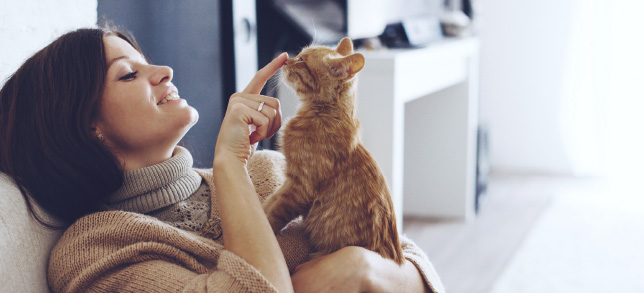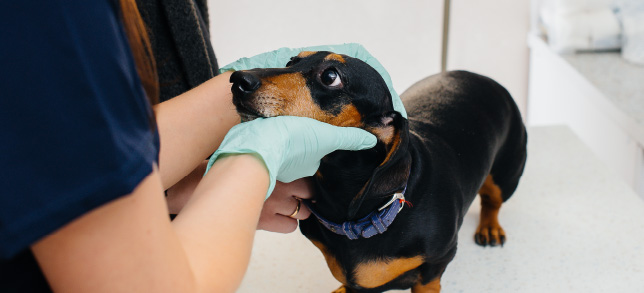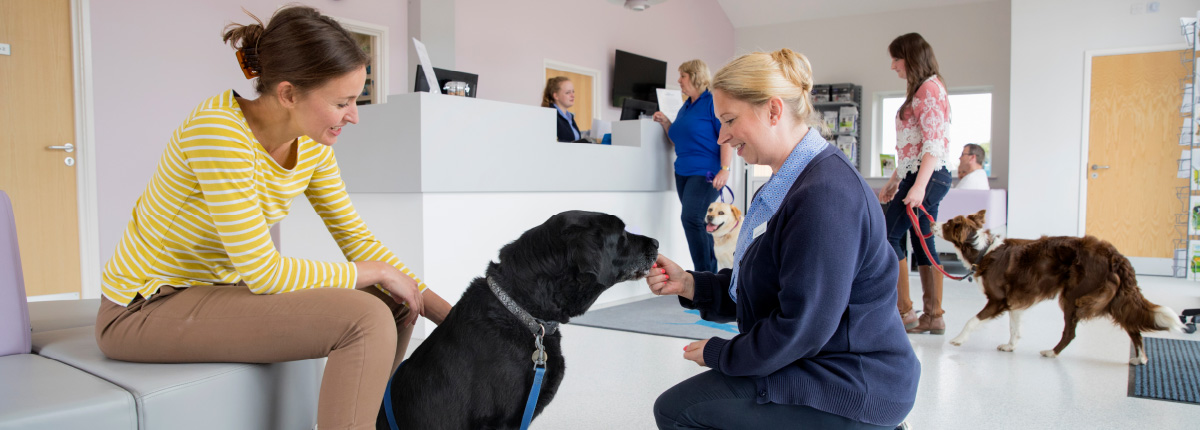How air quality is the key to a high-performing veterinary clinic
A visit to the vets can be a stressful experience for pets and their owners alike.
Whilst your customers might be anxious about the health of their pets, the treatment they’re likely to receive, or even the cost of the visit, the animals themselves can also easily be unsettled by a new environment.
Every clinic operator is likely to frequently consider the quality of their treatments, the training of their staff, and the importance of balancing their budget. But what they might not consider is the significant impact of their clinic environment. Not only can it affect the emotional state of their customers, but also the workload of their staff and the effectiveness of their treatments.
And with veterinary clinics operating in a competitive market, giving customers a comfortable and relaxing experience is key to keeping them onside and ensuring you continue to collect good reviews and a diary full of appointments.
Demand for veterinary clinics is higher than ever
First, the good news.
The Covid-19 pandemic triggered a dramatic surge in pet ownership across much of the world, as people looked for comfort from animals to see them through. As a result, 50%*1 of veterinary clinics across the UK reported an increase in their client base since the start of the pandemic. This figure was as high as 65% in the Netherlands.
Whilst that meant clinics found themselves flush with customers, and highly in demand, it has also increased the competitiveness of clinic operators as they try to capture a larger share of the market.
That means getting your environment right could make the difference between running a business that blossoms and one that fades into the background.

At the same time, providing a high-quality environment is harder than ever
Just as veterinary clinics found themselves dealing with increased customer demand, working conditions became trickier to manage.
The Covid-19 pandemic greatly increased concerns around the risk of viral infection in any shared environment, and veterinary clinics were no different. Operators were required to ramp up their cleaning and hygiene regimes and to use stronger sanitising chemicals, and some also enforced shoe covers and wait times between customers.
Even clinics with outstanding levels of cleanliness prior to the pandemic were forced to strengthen their regimes in order to ensure the protection of their staff and customers, and to appease visitors’ anxiety. At the same time, veterinary clinics need to be very careful about which cleaners they use, due to the risk of pets licking surfaces and ingesting an unpleasant compound that may cause a reaction.
These additional measures not only put extra strain on staff, but also reduced the number of customers that vets were able to see each day.
All this has made for a more challenging business environment than ever before.
A renewed focus on climate control and air quality

Temperature and ventilation control have always been important for a successful veterinary clinic, as animals can be quite sensitive to varying temperatures.
Specialised rooms also have particular needs – for example, many medicines stored in your pharmacy are likely to need to be kept out of the fridge but below 24 degrees Celsius. Elsewhere, a cooler temperature may be required: As one UK-based operator put it, “We need three people inside the room for surgery and they are dressed, so it gets really hot.” You also need to be able to adjust temperatures in real time for when a room becomes busy with animals and warms up fast.
Equally, air quality has become a far more significant consideration as a result of the pandemic. The air around us contains millions of particles of bacteria, viruses, particulate matter, mould, and allergens, and Covid-19 has driven awareness of the importance of supplying clean air to customers.
Some clinics continue to reduce the access pet owners have, or schedule additional room ventilation time between treatment or diagnosis sessions. This puts a further squeeze on their incomes.
Tip – Get control of your temperature and ventilation
Air conditioning is commonly used to control the temperature of veterinary environments, but during the pandemic concerns were raised about basic systems which fail to tackle the infection risks posed by circulated air.
It’s no surprise that clinic operators are increasingly turning to combined air purification and conditioning systems that tackle the health risks of viruses, bacteria, and mould, and cut back the ventilation time they need to leave between pets.
Dirt and odours have a significant impact on pets’ experience
Pets, by their very nature, create dust and dirt when they visit a veterinary clinic. The problem is at its worst during extended periods of wet weather, which can quickly leave your reception area looking like a mud bath.
And it’s not only the pets. Businesses on major roads find that the customers themselves can easily walk dust into the clinic, which quickly spreads from room to room. Plus, the risk of Covid-19 transmission means reducing contact time and ensuring people maintain sufficient distancing is key. Customers continue to expect high-use touchpoints to be sanitised regularly, and this and all the other extra cleaning needs are particularly demanding on staff time.
Tip – Get your reception area right
Appropriate reading materials, music, and TV displays can provide a good calming distraction for anxious owners waiting for appointments, as well as an opportunity to advertise your pet vaccination services or healthcare plans.
As one UK operator put it, “The number-one thing that clients complain about is waiting.” That’s because, for animals, mixing can create tension and even scraps or fights. In an ideal world, small dogs, cats, and big dogs would all have separate areas to wait in, and – if your resources stretch that far – entirely different entrances to come in through.
Even then, particularly stressed and noisy animals, or those depositing blood or faeces on your floor, will likely need to wait outside, and staff must stay on top of cleaning as much as they can.
Amongst the many traces left by the wide range of pets that visit your clinic each day are – of course – smells.
Animals have a highly refined sense of smell (dogs for example are up to 100,000 times*2 more sensitive to smells than humans), and that makes them particularly responsive to odours left by other animals. These can unsettle, agitate, and even distress visiting pets.
Odour is one of the biggest challenges that successful veterinary clinics need to address, especially if they experience a high pet turnover each day or need to reduce the time between customers in order to fit more appointments in.
Tip – Deal with odours, fast
A comfortable and relaxed animal will be much easier to deal with for your staff, so setting off on the right foot from the moment they arrive can make all the difference in ensuring a smooth operation. Smells play a big part in that experience: As one UK operator put it bluntly, “Sometimes in the reception animals can have diarrhoea or sickness, and also some dogs can be particularly smelly.”
At the same time, it’s important to be careful about how you address the problem. Some scented aroma diffusers for example can stress out animals – not to mention the fact that they simply add to a complicated odour profile, rather than removing any of the troublesome smells.
Adequate ventilation – and odour control – therefore remains the holy grail of creating a relaxing and welcoming environment. Get it right, and each pet will stay calm and relaxed when it’s their turn.

Introducing nanoe™ X technology: All-in-one air purification, and deodorisation for quality air
Air purification technology such as nanoe™ X can be integrated into air-conditioning units to tackle bad smells, airborne viruses, bacteria, mould, and hazardous substances contained in fine particulate matter (PM 2.5), and provide ventilation and temperature control.
With 24-hour deodorisation staff will no longer need to actively address bad smells; customers will always be greeted with purified air, and extended wait times between pets can be returned to normal.
nanoe™ X spreads nature-derived hydroxyl radicals through the air, actively removing the causes of infection and bad smells, and helping to deactivate viruses on surfaces. It can help your clinic stay clean and create a calmer, healthier environment for pets, owners, and staff.

Getting your environment right is key
When rising to the challenge of growing demand and increased hygiene expectations from your customers, it’s important to maximise the time your staff are able to treat animals.
Getting on top of your air quality and odour control not only creates a healthier and more relaxing environment for your customers and their pets, but it can also help reduce the wait time you need to leave between appointments.
nanoe™ X can help by providing 24-hour deodorisation, removing harmful viruses and bacteria from the air, and contributing to a cleaner environment. Making life easier for your staff, more comfortable for your customers, and helping you to stay competitive.
[Note]
*1 Statistics taken from the 2020 VetsSurvey:
*2 Figure taken from Dr. Michael T. Nappier
Click here to contact us about products with nanoe™ X technology









